Marita, red fruit pandan
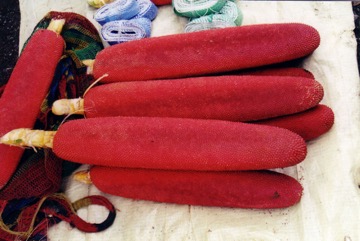
A tropical plant. It grows throughout PNG from sea level up to 1650 m altitude. It becomes common above 500 m. It can be up to 2,500 m above sea level. It occurs in Papua Province in Indonesia and in Maluku. In Townsville Botanical Gardens.
Also known as:
Abare, Abo, Aga, Alakape, Anga, Awom mangkaki, Awone mangkaki, Awone waransir, Besbes, Bunam, Bunumia, Deg, Hase, Katai, Ka yo, Kleba, Koba, Kobokana, Oga, Oka, Pandan buah merah, Pandan seran, Pangu, Saik, Saj, Saun, Siho, Sihu, Sina, Si-tararak, Supa, Vurume, Wabel
Synonyms
- Bryantia butyrophora Webb
- Pandanus butyrophorus (Webb) Kurz.
- Pandanus ceramicus Kunth [Illegitimate]
- Pandanus cominsii Hemsl.
- Pandanus cominsii var. augustus B. C. Stone
- Pandanus cominsii var. micronesicus B. C. Stone
- Pandanus englerianus Martelli
- Pandanus erythros H. St. John
- Pandanus hollrungii f. caroliniana Martelli
- Pandanus latericius B. C. Stone
- Pandanus magnificus Martelli
- Pandanus minusculus B. C. Stone
- Pandanus plicatus H. St. John
- Pandanus ruber H. St John
- Pandanus subumbellatus Becc. ex Solms
- Pandanus sylvestris Kunth [Illegitimate]
Edible Portion
- Fruit, Spice
Where does Marita grow?
Found in: Asia, Australia, Indonesia, Pacific, Papua New Guinea, PNG, SE Asia, Solomon Islands, Vanuatu, West Papua
Notes: There are about 600 Pandanus species. They grow in the tropics.
Status: In Papua New Guinea, a popular and common seasonal food in mid altitudinal zones.
Growing Marita, red fruit pandan
Cultivation: Marita pandanus are normally planted from suckers or cuttings. The cuttings are using ends of branches. Suckers produce more quickly. A new shoot normally sprouts out of the branch just below where the end was cut off. The cutting will soon develop roots and become established when it is planted. A more popular method is to use a sucker or shoot growing from the plant down near the ground. The sucker is separated from the parent plant then replanted in its new place. These suckers grow more quickly and can bear fruit after 18 months to 2 years. A cutting off a branch may take up to 4 or 5 years before it produces a fruit. Marita is often planted along the roads and walking tracks. It is also planted in most gardens and serves as a reminder that the land is owned by the person who planted the marita. So plants are dispersed instead of being grown in a plantation. A marita fruit is harvested when the colour starts to change to a brighter red or yellow. Sometimes it also starts to crack slightly at this stage. The fruit is cut from the branch. The ripe fruit is cooked then the juice mixed with water to make a sauce. To do this, a ripe marita fruit is normally split into 3 sections along its length. Then the central yellow stalk and pith area are dug out. The outside hard red layer is then cooked. Preferably it is cooked using hot stones although sometimes it is boiled in a saucepan. After cooking for about half an hour the hard pits are squeezed from the soft red juice by squeezing through the hands. Water is added to make an oily red soup. The soup is then eaten. Sometimes it is eaten by dipping green leaves or sago into the soup. At other times it is eaten with a spoon made from the marita leaf. Some people just suck the cooked juice from the seeds. As well, some people use the oily juice to cook food in. The pits or seeds are thrown away, normally to pigs. A harvested marita fruit will only keep for about one week. After cooking it will only last for about 12 hours.
Edible Uses: The ripe fruit is cooked then the juice mixed with water to make a sauce.
Production: Marita is a seasonal crop but the fruiting season is not a short clearly marked one. The main season goes from about October to March but individual trees can bear almost throughout the year. Near the sea the marita season is longer and more spread out but as the places increase in altitude above sea level the season becomes more distinct. The marita season is an important occasion. During the season people often use marita twice a day.
Nutrition Info
per 100g edible portion| Edible Part | Energy (kcal) | Protein (g) | Iron (mg) | Vitamin A (ug) | Vitamin c (mg) | Zinc (mg) | % Water |
|---|---|---|---|---|---|---|---|
| - | - | - | - | - | - |
Marita, red fruit pandan Photos

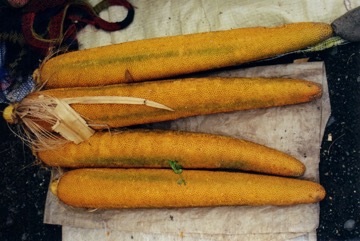
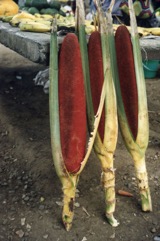
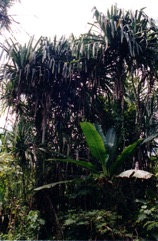
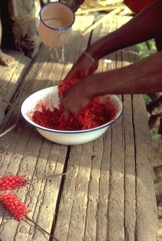
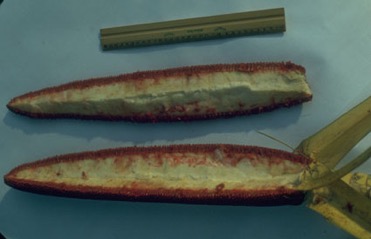
References
Marita references Pandanus conoideus
Altschul, S.V.R., 1973, Drugs and Foods from Little-known Plants. Notes in Harvard University Herbaria. Harvard Univ. Press. Massachusetts. no. 1
Borrell, O.W., 1989, An Annotated Checklist of the Flora of Kairiru Island, New Guinea. Marcellin College, Victoria Australia. p 39, 100 +2,
Burkill, I.H., 1966, A Dictionary of the Economic Products of the Malay Peninsula. Ministry of Agriculture and Cooperatives, Kuala Lumpur, Malaysia. Vol 2 (I-Z) p 1673
French, B.R., 1986, Food Plants of Papua New Guinea, A Compendium. Asia Pacific Science Foundation p 210, p 162 (As Pandanus englerianus)
Gillaumin, R., 1954, Les Plantes utiles des Nouvelles-Hebrides (fin et complement) In: Journal d'agriculture tropicale et de botanique appliquee Vol. 1, No. 10-12 pp 453-460 (As Pandanus cominsii)
Hide, R., et al, 1979, A checklist of some plants in the territory of the Sinasina Nimai (Simbai Province, Papua New Guinea), with notes on their uses. Department Anthropology, University of Aukland
Keim, A.P., 2009, Pandanaceae ofthe island of Yapen, Papua (West New Guinea). Blumea 54, 2009: 255-266
Leach, G. J., 1988, Bush Food Plants of the Blackwater and Karawari Rivers Area, East Sepik Province, Papua New Guinea. Science in New Guinea 14(2). p 103
Lebot, V. & Sam, C., Green desert or ‘all you can eat’? How diverse and edible was the flora of Vanuatu before human introductions?. Terra australis 52 p 411 (As Pandanus cominsii)
Lepofsky, D., 1992, Arboriculture in the Mussau Islands, Bismarck Archipelago. Economic Botany, Vol 46, No. 2, pp. 192-211, (Also as Pandanus englerianus)
Milliken, W., 2000, Ethnobotany of the Yali of West Papua. Royal Botanic Garden, Edinburgh (near Baliem)
Peekel, P.G., 1984, (Translation E.E.Henty), Flora of the Bismarck Archipelago for Naturalists, Division of Botany, Lae, PNG. p 42, 43 (As Pandanus englerianus)
PROSEA handbook Volume 13 Spices. p 278
PROSEA (Plant Resources of South East Asia) handbook, Volume 2, 1991, Edible fruits and nut. p 240, p 242 (As Pandanus cominsii). Also (As Pandanus englerianus). (Also as Pandanus hollrungii), (As Pandanus magnificus)
Sillitoe, P. 1995, An Ethnobotanical Account of the Plant Resources of the Wola Region, Southern Highlands Province, Papua New Guinea. J. Ethnobiol. 15(2): 201-235
Stone, B., 1974, Bot. Jahr.
Sukarya, D. G., (Ed.) 2013, 3,500 Plant Species of the Botanic Gardens of Indonesia. LIPI p 742
Tarepe, and Bourke, M., 1992,
Walter, A. & Sam C., 2002, Fruits of Oceania. ACIAR Monograph No. 85. Canberra. p 210, 281 (Also as Pandanus magnificus)
Wickens, G.E., 1995, Edible Nuts. FAO Non-wood forest products. FAO, Rome. p172
Wiriadinata, H., 1995, Ethnobotany of Economic Plants in the Baliem Valley, Jayawijaya, Irian Jaya, Indonesian Institute of Science, Bogor, Indonesia
World Checklist of Useful Plant Species 2020. Royal Botanic Gardens, Kew
www.pngplants.org (As Pandanus cominsii); (Also as Pandanus englerianus), (As Pandanus hollrungii),